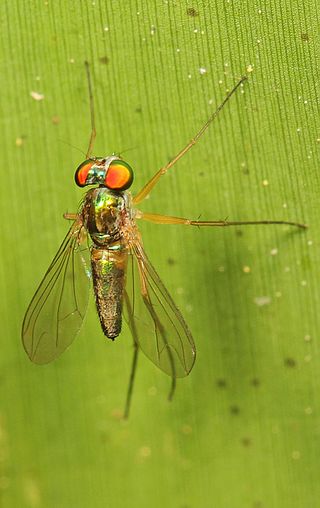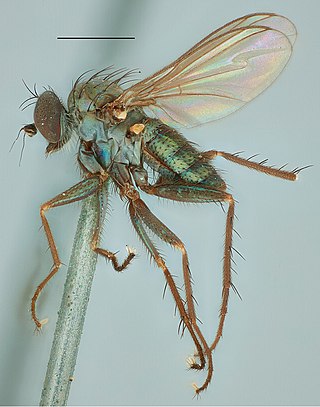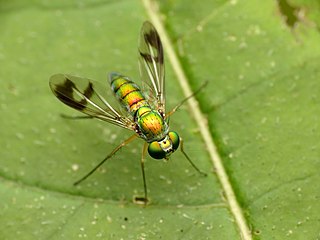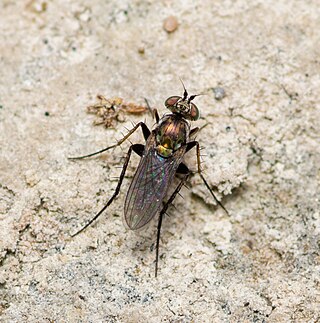
Amblypsilopus is a genus of flies in the family Dolichopodidae. It is a large genus, with about 350 species recorded. However, it is possibly polyphyletic.

Asyndetus is a genus of flies in the family Dolichopodidae. There are more than 100 species described for the genus, distributed worldwide.

Condylostylus is a genus of flies in the family Dolichopodidae. It is the second largest genus in the subfamily Sciapodinae, with more than 250 species included. It has a high diversity in the Neotropical realm, where 70% of the species occur.

Diaphorus is a genus of flies in the family Dolichopodidae. Lyroneurus was formerly considered a subgenus, but is now either treated as a synonym of Chrysotus or treated as a distinct genus.

Hydrophorus is a genus of flies in the family Dolichopodidae.

Medetera is a large genus of flies in the family Dolichopodidae. It includes about 350 species worldwide. The adults are commonly found resting on vertical surfaces such as tree trunks, on which they have a characteristic vertical upright stance. Because of this stance, they are sometimes known as "woodpecker flies". Medetera adults are predators of soft-bodied arthropods, while the larvae are predators of bark beetle larvae.
Mesorhaga is a genus of flies in the family Dolichopodidae.

Paraclius is a genus of flies in the family Dolichopodidae. It is currently considered a polyphyletic assemblage of species.
Saccopheronta is a genus of flies in the family Dolichopodidae. It is considered a synonym of Medetera by some authors, and a valid genus by others.

Sympycnus is a genus of flies in the family Dolichopodidae.

Syntormon is a genus of flies in the family Dolichopodidae. It includes about 110 species worldwide, more than 50 of which were described from the Palaearctic realm.

Tachytrechus is a genus of long-legged flies in the family Dolichopodidae.

Thinophilus is a genus of flies in the family Dolichopodidae. It includes about 146 described species distributed worldwide. Most species of the genus are found in coastal habitats, while a few species are found in freshwater habitats.

Diaphorinae is a subfamily of flies in the family Dolichopodidae.
Lyroneurus is a genus of flies in the family Dolichopodidae. It includes 17 species distributed in the Neotropical realm. It was formerly treated as a subgenus of Diaphorus; more recently Lyroneurus has been treated as a synonym of Chrysotus, but Capellari & Amorim (2010) maintains it as a distinct genus noting that Chrysotus is possibly paraphyletic.












